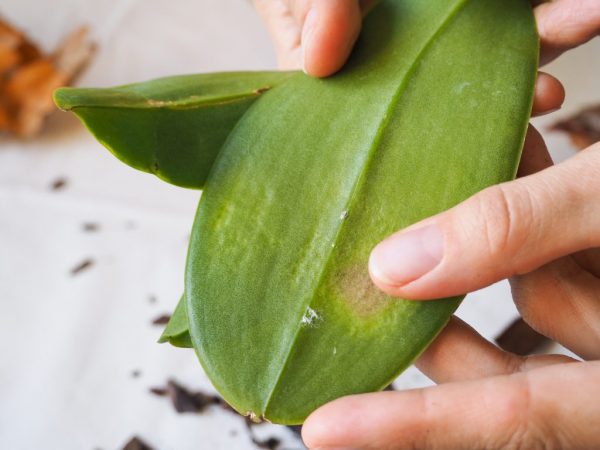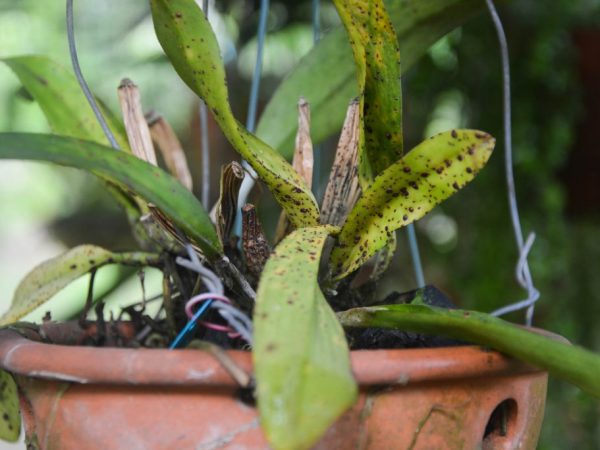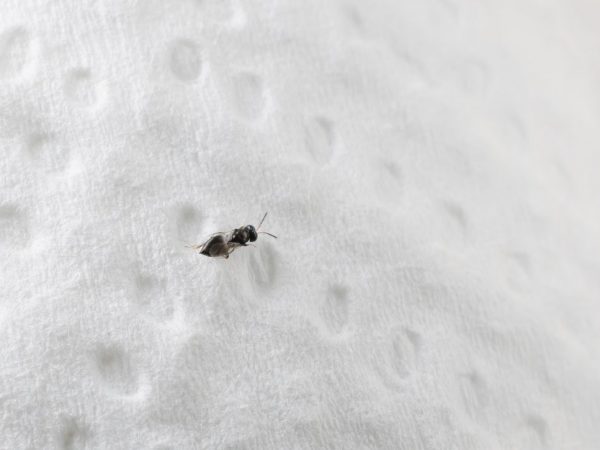Description of orchid pests
Cultivating an indoor orchid, flower growers have to deal with parasites that infect it. There are several types of orchid pests, and each of them should be dealt with in its own way.

Orchid pests
The destruction of harmful insects at home and in greenhouses is carried out using pesticides. Chemistry treatment helps fight parasites, but the likelihood of their reappearance is high. The thing is that flower pests have a larval stage - during the dormant period, small larvae painlessly tolerate several chemical treatments.
Each type of parasite has its own scheme and treatment interval. This makes it possible to destroy the larvae during their transformation into a more mature stage of development.
Causes of pests
There are several common reasons why parasites appear on phalaenopsis orchids:
- The purchased copy was already infected. When buying a plant, it is important to carefully examine it for damage by harmful insects.
- Infected substrate. Purchased primer should be used.
- Insects have moved from one plant to another. This happens with an abundance and thickening of indoor vegetation.
Common pests of orchids
Flowers are most often affected by such parasites:
- mealy and root worm;
- mite;
- mushroom gnat;
- shield;
- thrips;
- podura;
- nematode;
- whitefly.
Mealybug
This insect is a dangerous pest of the phalaenopsis orchid. It starts in the bark used to prepare the substrate for plants, or is brought in with dust or other pests: aphids, ants.
Worms settle on flowers, in the ground, on the roots, at the base of the stem, under the scales of the leaves. With a massive invasion, a white bloom appears on the plant, similar to cotton or cobweb.
Females lay eggs on the underside of the leaf plate. The hatched larvae suck the juice from the leaves of the plants, then sink into the soil and parasitize on the roots.
To remove the mealybug, the root system of the plant is washed with Fitoverm. All damaged parts on the flower are removed and treated with charcoal powder. The flower is transplanted into a new substrate.
For the purpose of prevention, the new soil is re-cultivated. Every 5 days, the leaves are wiped with the same product 3 times.
To prevent the reappearance of the parasite on the plant, you should remove withered and dried leaves in time, try not to overflow the flower and provide it with good lighting.
Nematodes
Parasitic insects settle on leaves, stems or roots. There are several varieties of nematodes, but white or transparent worms up to 1 mm long are most often found on orchids.
These phalaenopsis orchid pests feed on plant sap, after which the affected areas turn brown or black, and then die off.
If you notice these signs, the plant should be quarantined immediately because the nematode moves to other flowers.
Treatment:
- "Dekaris". 1 crushed tablet in 1 liter of water. The prepared solution is poured over the substrate.
- The use of drugs-nemasticides: "Diazinon", "Heterophos", "Fensulfotion", "Carbofuran", "Aldicarb" and "Thionazin".
Affected flowers should be handled carefully. These drugs are highly toxic to humans and pets. In order to no longer meet nematodes on orchids, you should try to improve care.
Shields
In appearance, these insects are somewhat reminiscent of a match head. They parasitize on pseudobulbs, leaves and stems. Small scale insects, about 0.2 cm in size, in the course of their vital activity, secrete sticky droplets, in which a sooty fungus multiplies. Dark spots on the surface of the plant indicate the presence of a parasite.
Control measures:
- Manually remove the pest from the flowers.
- Spray the plant with Fitoverm or Actellik. Re-treat after 7 days.
- Move the flower to another pot with a new substrate, pre-rinse the roots with phytoverm.

Orchid scabbard
Puffs
Leg-tails, or podura, are small caterpillars of a cream, sometimes white, light green color with antennae. Their size is about 2 mm. On the abdomen of insects there is a special shield with which they can jump. This unique ability of caterpillars allows you to distinguish leaping suckers from mealybugs.
The first step in getting rid of parasites is to stop watering. If this does not help, insecticides are used.
The drug "Bazudin" helps to get rid of the parasite. It is scattered in a thin layer on the surface of the substrate. After a few hours, the pests die.
Other means also help to fight orchid pests: "Aktara", "Pochin" and "Mospilan". To get rid of parasites, the land is cultivated at least 2 times with a frequency of 10 days.
Mites
There are several types of ticks:
- Root (bulbous). The adult insect is white, the larvae and eggs are yellow. The danger of this pest is that it is almost impossible to notice it. This insect gets inside the roots, sucks out the juice and deprives the flowers of nutrition. At the advanced stage of the lesion, the roots have only a shell with voids inside. The bulb mite is a carrier of a fungal disease.
- False spider web (flat body). This is a red or red insect that feeds on leaf sap. The affected foliage first turns gray, then turns brown and falls off.
- Red spiderweb. This is a small spider of red color, braiding foliage with cobwebs. It sucks juices from tissues, as a result of which the leaves turn yellow, curl and fall off. Orchids do not form flower buds when infested by the parasite.
Control methods
For effective control, the root system is removed, the dead parts are removed and the plant is watered with Fitoverm, then the plant is transplanted into a new sterilized substrate. Also, the aerial part is treated twice with the same agent with a frequency of 7 days.
To cure a plant with an invasion of a red spider mite, the flower should be treated with phytoverm. Spray 3 times at intervals of 5 days at a temperature not lower than 30 ° C. To exclude its reappearance, high humidity is provided in the room.
To exterminate the flattened mite, the flower is sprayed with the same means and in the same way as in the previous case.
Midges
There are several varieties of gnats that live on indoor orchids. Knowing which species of midges parasitizes on the orchid, they determine how to deal with the pest.
Sciarids
These are small black insects with a length of 3 to 5 cm. Sciarids are popularly called flower midges.
They lay eggs in the ground, from which white, worm-like larvae begin to develop.Such worms do no harm to plants. They pose a great danger to the root system. Sciaris worms often appear in the soil of weakened or young orchids.
Fungal infection and root rot develop in the damaged areas.
It is possible to save the plant, but it is easier to prevent the appearance of parasites by using special sterilized substrates for growing flowers. If the preparation of the soil is carried out at home, it is thoroughly calcined in the oven, or it is kept in the cold for a day. In order to avoid infestation by midges, it is forbidden to fertilize flowers with tea, thickening coffee, food leftovers.
They fight against pests of this species of orchids using the drug "Thunder-2" or "Bazudin". The soil is sprayed in a pot, and after a week the procedure is repeated.

Sciaris
Whiteflies
Whitefly butterflies are pests of phalaenopsis orchids, similar to white flies. At the slightest touch of a flower, they quickly fly into the air.
Adults and their larvae feed on foliage sap. Severely affected specimens gradually wither, their leaves turn yellow and curl up into a tube.
The fact that these pests are bred on flowers is determined by the presence of eggs and whitefly larvae. They are concentrated on the underside of the leaf blade, under the bark and on the surface of the substrate.
Thrips
It is difficult to notice these insects because they are nocturnal. Small pests of black color, 2.5 mm in size, feed on orchid juice, affecting not only the leaves, but also the buds, flowers, and the root system. In appearance, they resemble sticks with two pairs of wings folded on the back. Habitat - soil substrate.
You can see the parasites by carefully examining the soil in the pot. Also, dark spots on the leaves indicate the presence of thrips.
Fruit midges
Fruit midges (fruit fly) are attracted by rotted soil, watering the plant with tea. These reddish small flies, 1-2 mm in size, multiply rapidly in a humid environment, especially in places where there are rotting fruits, rotting remains of vegetation.
They warn that the plant is suffering from excess moisture. And this threatens the development of root rot and wilting of the flower.
They get rid of midges by reducing the dose and frequency of watering, as well as removing from the room any food debris that sour or rot.
Orchid care rules
In order not to resort to the treatment of phalaenopsis orchid pests, they carry out preventive measures, provide the plant with competent care.
Expert advice:
- Provide good lighting for the orchid. Do not put it in the sun, otherwise it will get severe burns, the leaves will turn yellow, and the flower will become vulnerable to many pests. It requires 12 hours of diffused light.
- Provide the plant with a stable temperature regime within 20-27 ° С during the day and 15-23 ° С at night.
- Water not too often and in small doses to prevent overflow. The soil should not dry out, otherwise the plant will lose its decorative effect and weaken. The water is used warm, settled.
- Spray the orchid regularly in the morning.
- Fertilize flowers every 3 weeks.
Conclusion
Regular inspection of plants for the presence of diseases and pests helps to detect the problem in time.
Orchid pest control methods depend on the type of parasite, which is why it is so important to know from the name and description.


